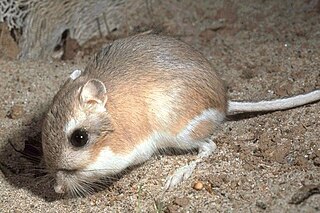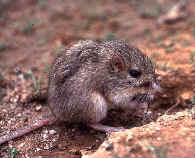
Kangaroo rats, small mostly nocturnal rodents of genus Dipodomys, are native to arid areas of western North America. The common name derives from their bipedal form. They hop in a manner similar to the much larger kangaroo, but developed this mode of locomotion independently, like several other clades of rodents.

Heteromyidae is a family of rodents consisting of kangaroo rats, kangaroo mice, pocket mice and spiny pocket mice. Most heteromyids live in complex burrows within the deserts and grasslands of western North America, though species within the genus Heteromys are also found in forests and their range extends as far south as northern South America. They feed mostly on seeds and other plant parts, which they carry in their fur-lined cheek pouches to their burrows.

Perognathinae is a subfamily of rodents consisting of two genera of pocket mice. Most species live in complex burrows within the deserts and grasslands of western North America, They feed mostly on seeds and other plant parts, which they carry in their fur-lined cheek pouches to their burrows.

The rock pocket mouse is one of 19 species of pocket mice in the genus Chaetodipus. It is sometimes grouped in the genus Perognathus.

The desert pocket mouse is a North American species of heteromyid rodent found in the southwestern United States and Mexico. True to its common name, the medium-sized desert pocket mouse prefers sandy, sparsely vegetated desert environments.

The hispid pocket mouse is a large pocket mouse native to the Great Plains region of North America. It is a member of the genus Chaetodipus.
The Arizona pocket mouse is a rodent native to the Sonoran desert. It is a small mouse with a thinly furred tail that is smooth from base to tip. In color it ranges from tan to orange. It is a nocturnal, burrowing animal. It eats seeds, which it carries back to its burrow in its cheek pouches.

The little desert pocket mouse is a species of small rodent in the family Heteromyidae. It is endemic to Baja California in Mexico.
The narrow-skulled pocket mouse is a species of rodent in the family Heteromyidae. It is endemic to western Mexico, living west of the Sierra Madre Occidental crest.

Bailey's pocket mouse is a species of rodent of the subfamily Perognathinae, family Heteromyidae. It is found in Baja California, Sinaloa and Sonora in Mexico and in California, Arizona and New Mexico in the United States.

The California pocket mouse is a species of nocturnal and primarily solitary rodent in the family Heteromyidae.

Nelson's pocket mouse is a species of rodent in the family Heteromyidae. It is found in Mexico and in New Mexico and Texas in United States. It is named in honor of the American naturalist Edward William Nelson.

The Sinaloan pocket mouse is one of 17 species of pocket mice in the genus Chaetodipus. Two subspecies of C. pernix are recognized, C. p. pernix and C. p. rostratus, all are endemic to Mexico.

The spiny pocket mouse is a species of rodent in the family Heteromyidae and order Rodentia. It is found in Baja California in Mexico and in Arizona, California and Nevada.

Merriam's kangaroo rat is a species of rodent in the family Heteromyidae. The species name commemorates Clinton Hart Merriam. It is found in the Upper and Lower Sonoran life zones of the southwestern United States, Baja California, and northern Mexico.

The banner-tailed kangaroo rat is a species of rodent in the family Heteromyidae. It is found in arid environments in the southwestern United States and Mexico where it lives in a burrow by day and forages for seeds and plant matter by night.

The silky pocket mouse is a species of rodent in the family Heteromyidae. It is found in northern and central Mexico and the southwest region of the United States. It is a species of least concern, according to the IUCN, with no known major threats. The silky pocket mouse eats seeds, succulent parts of plants and nuts, and carries food in its cheek pouches. It lives in low valley bottoms with soft soils, among weeds and shrubs, where it burrows in the sand to bury seed caches. The species is more tolerant of harsh habitat conditions than other pocket mice.

Merriam's pocket mouse is a species of rodent in the family Heteromyidae. It is found in northeast Mexico and New Mexico, Oklahoma and Texas in the United States. Its habitat is shortgrass prairie, desert areas with scrub and arid shrubland. The species is named to honor Clinton Hart Merriam, a biologist who first described several other members of the genus Perognathus, and first elucidated the principle of a "life zone" as a means of characterizing ecological areas with similar plant and animal communities.

The Pacific pocket mouse, Perognathus longimembris pacificus, is endemic to California. It lives in sandy coastal soils of the coastal sage scrub ecoregion. It eats seeds and some insects. It was believed to be extinct until 1993, when a small population was discovered. It is now a federally listed Endangered animal species.

The Chihuahuan pocket mouse is a species of heteromyid rodent found in the southwestern United States and Mexico. It was formerly considered a subspecies of the desert pocket mouse, but was determined to be a distinct species in 1996, following analysis of its mitochondrial DNA.

















